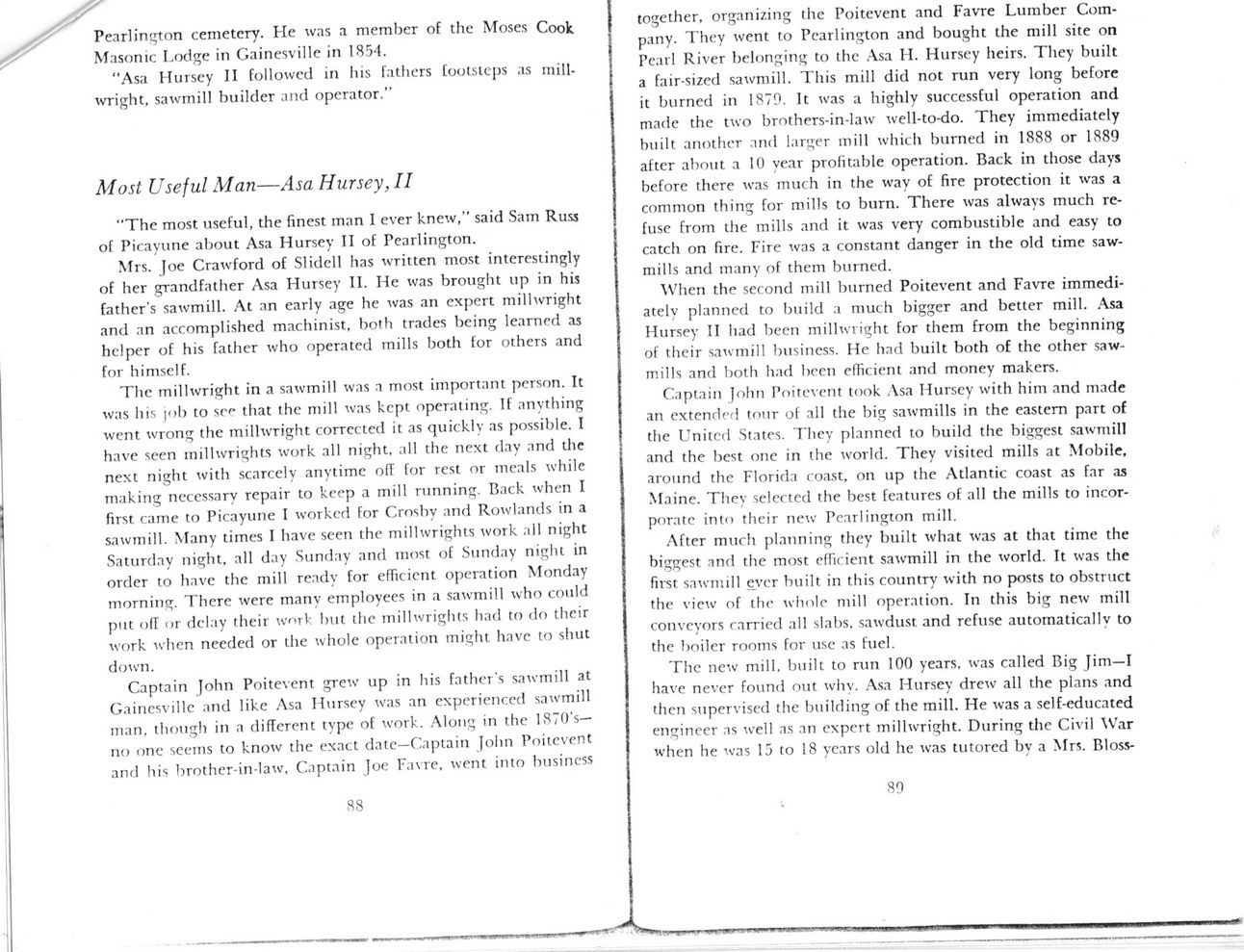This text was obtained via automated optical character recognition.
It has not been edited and may therefore contain several errors.
Pearlington cemetery. He was a member of the Moses Cook. Masonic Lodge in Gainesville in 1854. "Asa Hursey II followed in his fathers footsteps as millwright, sawmill builder and operator.? Most Useful Man?Asa Hursey, II "The most useful, the finest man I ever knew,? said Sam Russ of Picayune about Asa Hursey II of Pearlington. Mrs. foe Crawford of Slidell has written most interestingly of her grandfather Asa Hursey II. He was brought up in his father?s sawmill. At an early age he was an expert millwright and an accomplished machinist, both trades being learned as helper of his father who operated mills both for others and for himself. The millwright in a sawmill was a most important person. It was his |ob to scr that the mill was kept operating. If anything went wrong the millwright corrected it as quickly as possible. I have seen millwrights work all night, all the next day and the next night with scarcely anytime off for rest or meals while making necessary repair to keep a mill running. Back when I first came to Picayune I worked for Crosby and Rowlands in a sawmill. Many times I have seen the millwrights work all night Saturday night, all day Sunday and most of Sunday night in order to have the mill ready for efficient operation Monday morning. There were many employees in a sawmill who could put off or delay their work but the millwrights had to do their work when needed or the whole operation might have to shut down. Captain John Poitevent grew up in his father's sawmill at Gainesville and like Asa Hursey was an experienced sawmill man. though in a different type of work. Along in the 1870?s? no one seems to know the exact date?Captain John Poitevent and his brother-in-law, Captain Joe Favre, went into business 88 together, organizing the Poitevent and Favre Lumber Company. They went to Pearlington and bought the mill site on Pearl River belonging to the Asa II. Hursey heirs. They built a fair-sized sawmill. This mill did not run very long before it burned in 1879. It was a highly successful operation and made the two brothers-in-law well-to-do. They immediately built another and larger mill which burned in 1888 or 1889 after about a 10 year profitable operation. Back in those days before there w'as much in the way of fire protection it was a common thing for mills to burn. There was always much refuse from the mills and it was very combustible and easy to catch on fire. Fire was a constant danger in the old time sawmills and many of them burned. When the second mill burned Poitevent and FavTe immediately planned to build a much bigger and better mill. Asa Hursey II had been millwright for them from the beginning of their sawmill business. He had built both of the other sawmills and both had been efficient and money makers. Captain John Poitevent took Asa Hursey with him and made an extended tour of all the big sawmills in the eastern part of the United States. They planned to build the biggest sawmill and the best one in the world. They visited mills at Mobile, around the Florida coast, on up the Atlantic coast as far as Maine. They selected the best features of all the mills to incorporate into their new Pearlington mill. After much planning they built what was at that time the biggest and the most efficient sawmill in the world. It was the first sawmill ever built in this country with no posts to obstruct the view of the whole mill operation. In this big new mill conveyors carried all slabs, sawdust and refuse automatically to the boiler rooms for use as fuel. The new mill, built to run 100 years, was called Big Jim?I have never found out why. Asa Hursey drew all the plans and then supervised the building of the mill. He was a self-educated engineer as well as an expert millwright. During the Civil War when he was 15 to 18 years old he was tutored by a Mrs. Bloss- 80

Hursey~Hussey 004